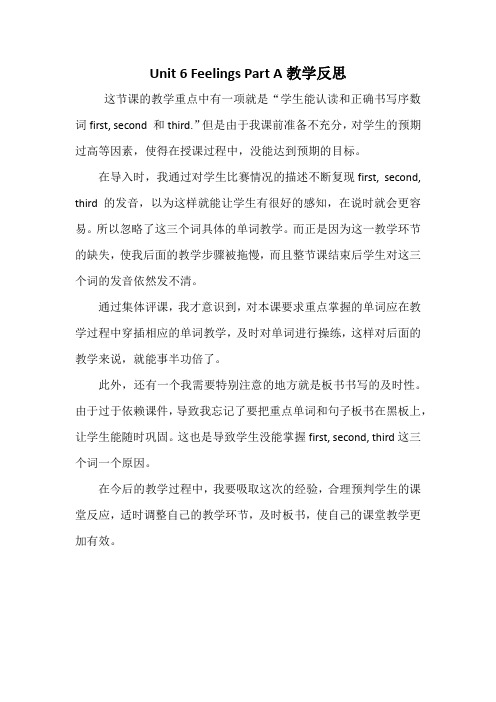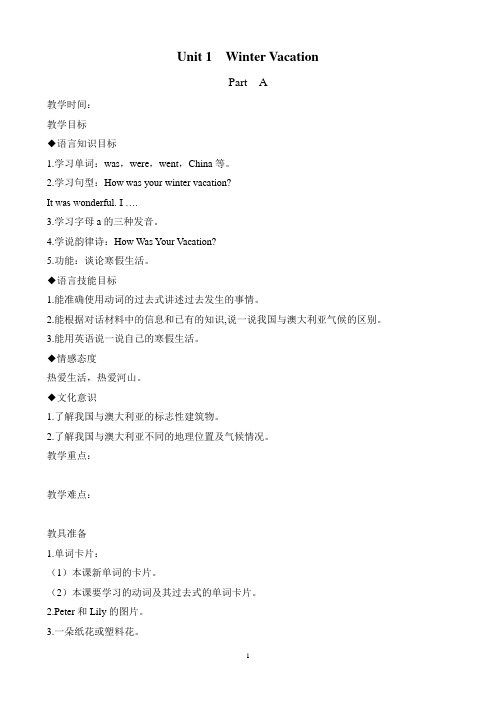闽教版五年级英语下册教案新部编本(全册)
- 格式:doc
- 大小:271.00 KB
- 文档页数:34

闽教版(2023修订版)英语五年级下册教案Unit 1: Getting to know youLesson 1: Hello!Objectives:- Greet others using "Hello" and "Hi"- Introduce yourself by saying "My name is..."- Respond to simple questions like "How are you?" with "I'm fine, thank you"Materials:- Flashcards with pictures of people- Whiteboard and markers- Recordings of greetings and introductionsProcedure:1. Start by greeting the students and introducing yourself using "Hello, my name is _____."2. Show the flashcards of people and ask the students to say hello to each person.3. Play the recordings of greetings and introductions for the students to listen to and repeat.4. Write the phrase "My name is ____" on the board and ask the students to practice introducing themselves to a partner.5. Ask some students how they are doing and model the response "I'm fine, thank you" for them to use.Assessment:Lesson 2: What's your name?Objectives:- Ask and answer basic questions about someone's name- Use "nice to meet you" in a conversation- Review the phrases from Lesson 1Materials:- Picture of a fictional character- Whiteboard and markers- Recordings of basic questionsProcedure:1. Introduce the fictional character and ask the students if they know the character's name.2. Model the question "What's your name?" and have the students practice asking and answering the question with their partners using their own names.3. Ask some students if they have any questions for you and model the response "Nice to meet you" for them to use.4. Play the recordings of basic questions and have the students practice asking and answering questions with their partners.5. Review the phrases from Lesson 1 by having the students greet each other and introduce themselves.Assessment:Observe the students as they ask and answer questions to make sure that they are using the correct phrases and grammar.Unit 2: Where are you from?Lesson 1: Countries and nationalitiesObjectives:- Learn the names of different countries and nationalities- Ask and answer questions about someone's nationalityMaterials:- World map- Pictures of people from different countries- Whiteboard and markers- Recordings of nationalities and countriesProcedure:1. Show the world map and point out different countries.2. Show the pictures of people from different countries and teach the names of the countries and nationalities.3. Model the question "Where are you from?" and have the students practice asking and answering the question with their partners.4. Play the recordings of nationalities and countries for the students to listen to and repeat.5. Have the students work in pairs and take turns asking and answering questions about each other's nationalities.Assessment:Observe the students as they ask and answer questions to make sure that they are using the correct vocabulary and grammar.Lesson 2: My cityObjectives:- Learn basic vocabulary related to a city- Ask and answer questions about someone's cityMaterials:- Pictures of a city- Whiteboard and markers- Recordings of basic questionsProcedure:1. Show the pictures of a city and teach the names of different places like a school, a park, a hospital, etc.2. Model the question "What's your city like?" and have the students practice asking and answering the question with their partners.3. Play the recordings of basic questions and have the students practice asking and answering questions with their partners.4. Have the students work in pairs and take turns asking and answering questions about each other's cities.Assessment:Observe the students as they ask and answer questions to make sure that they are using the correct vocabulary and grammar.。

Unit 6 Feelings Part A教学反思这节课的教学重点中有一项就是“学生能认读和正确书写序数词first, second 和third.”但是由于我课前准备不充分,对学生的预期过高等因素,使得在授课过程中,没能达到预期的目标。
在导入时,我通过对学生比赛情况的描述不断复现first, second, third的发音,以为这样就能让学生有很好的感知,在说时就会更容易。
所以忽略了这三个词具体的单词教学。
而正是因为这一教学环节的缺失,使我后面的教学步骤被拖慢,而且整节课结束后学生对这三个词的发音依然发不清。
通过集体评课,我才意识到,对本课要求重点掌握的单词应在教学过程中穿插相应的单词教学,及时对单词进行操练,这样对后面的教学来说,就能事半功倍了。
此外,还有一个我需要特别注意的地方就是板书书写的及时性。
由于过于依赖课件,导致我忘记了要把重点单词和句子板书在黑板上,让学生能随时巩固。
这也是导致学生没能掌握first, second, third这三个词一个原因。
在今后的教学过程中,我要吸取这次的经验,合理预判学生的课堂反应,适时调整自己的教学环节,及时板书,使自己的课堂教学更加有效。
闽教小学五年级英语下册语篇教学反思语篇教学是指在具体语境中教学单词和句型,主张把单词融入句子中教学,从整体入手,给学生展现一个完整的语言概念。
语篇教学的核心思想在于在课堂教学中创设语境,让学生在情景中体验并运用语言,更为具体地说就是通过有意义的语言输入来激活有意义的语言输出。
语篇教学一直是小学高年段英语教学的一个难点内容,它并非单纯的语篇知识的教学,它始终以学生为主体,以发展学生的能力为目的,让学生在教师的引导下感知、理解和运用所学语言。
在小学英语教学中进行语篇教学有利于提高学生的学习兴趣,激发学生学习的动力。
小学英语语篇教学倡导“词句结合,语篇感悟”,强调不仅重视语篇知识的传授,更重视语言能力的培养。
通过培训学习,我对语篇教学的重要性有了更进一步的认识,对如何利用教材呈现的每一篇语言材料,充分调动学生学习英语的兴趣,有了浅薄的认识。

新闽教版英语五年级下册全册教课设计Unit 1 Winter VacationUnit1 Part A一、教课内容:五年下册Unit 1 Part A.二、教课目:1.能正确使用的去式述去生的事情。
2.能依据资猜中的信息和已有的知 , 一我国与澳大利天气的区。
3.能用英一自己的寒假生活。
三、教课要点:1. 学: was, were,went,China 等。
2. 学句型: How was your winter vacation? It was wonderful. I⋯.3.学字母 a 的三种音。
4.功能:寒假生活。
5.法:一般去和去式的化。
四、教课点:1.掌握一般去和去式的化和不化。
2.能熟地用英寒假生活。
五、教课准:1.卡片:(1)本新的卡片。
(2)本要学的及其去式的卡片。
和Lily的片。
3.一花或塑料花。
4.音机或教课光。
六、教课方法:元教课、伙伴教课、合作学法、法七、教课程:Step 1 Warming up1.生互致候。
2.教播放音,全班学生唱歌曲: What Will You Do In Summer?Step 2 Review1.依据歌曲内容,教:“ Summer vacation is in July and August.(教在黑板右写出 July and August ) What will you do in summer? ”2.学生自由回答,教在黑板上 July and August 的下边写出一些学生到的句子中的,如:go to Beijingvisit the Great Wallwatch TVgo swimmingdo my homework⋯3.采纳不一样的方式操些,稳固中的音形。
4.呈。
( 1)教:“ Summer vacation is in July and August.Today is⋯.(将今日的日期板在 July and August的前面)Winter vacation is in⋯.(将寒假的日期写在今日日期的前面) Today let?s talk about the winter vacation.”板以下:(寒假的日期)(今日的日期)July and Augustgo to Beijingvisit the Great Wallwatch TVgo swimmingdo my homework( 2)揭露并板:Unit 1 Winter Vacation Part A。

Unit 1 Winter VacationPart A教学时间:教学目标◆语言知识目标1.学习单词:was,were,went,China等。
2.学习句型:How was your winter vacation?It was wonderful. I ….3.学习字母a的三种发音。
4.学说韵律诗:How Was Your Vacation?5.功能:谈论寒假生活。
◆语言技能目标1.能准确使用动词的过去式讲述过去发生的事情。
2.能根据对话材料中的信息和已有的知识,说一说我国与澳大利亚气候的区别。
3.能用英语说一说自己的寒假生活。
◆情感态度热爱生活,热爱河山。
◆文化意识1.了解我国与澳大利亚的标志性建筑物。
2.了解我国与澳大利亚不同的地理位置及气候情况。
教学重点:教学难点:教具准备1.单词卡片:(1)本课新单词的卡片。
(2)本课要学习的动词及其过去式的单词卡片。
2.Peter和Lily的图片。
3.一朵纸花或塑料花。
4.录音机或教学光盘。
教学过程Step 1 Warming up1.师生互致问候。
2.教师播放录音,全班学生齐唱歌曲:What Will You Do In Summer?Step 2 Review1.根据歌曲内容,教师说:“Summer vacation is in July and August.(教师在黑板右边写出July and August)What will you do in summer?”2.请学生自由回答,教师在黑板上July and August的下面写出一些学生说到的句子中的词组,如:go to Beijingvisit the Great Wallwatch TVgo swimmingdo my homework…3.采用不同的方式操练这些词组,巩固词组中动词的音义形。
4.呈现课题。
(1)教师说:“Summer vacation is in July and August.Today is ….(将今天的日期板书在July and August的前面)Winter vacation is in ….(将寒假的日期写在今天日期的前面)Today let’s talk about the winter vacation.”板书如下:(寒假的日期)(今天的日期)July and Augustgo to Beijingvisit the Great Wallwatch TVgo swimmingdo my homework(2)揭示课题并板书:Unit 1 Winter VacationPart A。

Unit1 Winter Va cation Part B教学设计【内容】闽教版五下Unit1 Part B【主题】Winter Vacation【课时】Part B一、教学目标(Teaching aims)(一)知识目标(Knowledge aims)1. 能听懂、会说、认读并规范书写单词:parent, hometown, took, lake, did.2. 能听懂、会说、认读单词和词组:tour, Sun Moon Lake, swam, play chess, took a boat, played the violin, did my homework.3. 能听懂、会说、认读并运用句型:①—How was your winter vacation?—I went to Taiwan with my parents.②I took a boat tour of Sun Moon Lake.4. 学说韵律诗:学唱歌曲:The Taiwan Island。
(二)能力目标(Ability aims)1. 学会运用所学句型讨论彼此假期生活。
2.能用英语说一说、写一写自己的家乡。
3. 能用英语介绍自己与家人或朋友的寒假生活。
(三)情感目标(Affective aims)通过了解台湾的一些著名的风景名胜,培养学生热爱祖国领土宝岛台湾。
二、教学重难点(Teaching points and difficulties)(一)重点(Points)1. 能听懂、会说、认读、书写单词:parent, hometown, took, lake, did.2. 能听懂、会说、认读并运用句型: ①—How was your winter vacation?—I went to Taiwan with my parents.②I took a boat tour of Sun Moon Lake.难点(Difficulties)能听懂、会说、认读并运用句型: ①—How was your winter vacation?—I went to Taiwan with my parents.②I took a boat tour of Sun Moon Lake.三、教学准备(Teaching preparation)教师准备:教学课件, 教学录音, 教学动画,人物头饰,动词及其过去式的单词卡片。

闽教版英语五年级下册全册教案Unit 1 Winter Vacation文化和语言注释1.本单元的话题是寒假生活和春节,语法主要内容是一般过去时和专有名词、冠词的用法,语音部分复习总结字母a在开音节、闭音节以及a在ss前的发音。
2.本套教材从五年级下册开始学习一般过去时,本单元的课文首次出现过去时。
一般过去时表示过去某个时间发生的动作或存在的状态,常和表示过去的时间状语连用,如:last year,yesterday等;也可表示过去经常反复发生的动作,常和often,always等频率副词连用。
如:He visited the Great Wall in winter vacation.(寒假他参观了长城。
)Last year I often went to school on foot.(去年我经常步行上学。
)3.动词过去式的构成:(1)规则动词过去式的构成有四条规则:①一般在动词原形末尾直接加上-ed。
如:look—looked,visit—visited,watch—watched。
②以不发音的字母e结尾的动词,只需加-d。
如:live—lived。
③末尾只有一个辅音字母的重读闭音节,先双写这个辅音字母,再加ed。
如:stop—stopped。
④末尾是“辅音字母+y”结尾的动词,先改y为i,然后再加-ed。
如:study—studied。
(2)不规则动词的过去式需要记忆。
如:am/is—was,are—were,go—went,come—came,take—took,have(has)—had等。
4. —How was your winter vacation?(你的寒假过得如何?)—It was wonderful. I visited the Great Wall.(好极了,我参观了长城。
)(1)was是is的过去式。
(2)wonderful是形容词,意思是“极好的,精彩的,绝妙的” 。
五年级英语下册全册表格式教案(闽教版)本资料为woRD文档,请点击下载地址下载全文下载地址课件www.5yk 课题Unit1ourschoolLesson1课时2课时班级五(1-3)一、教材内容分析.第六册Unit1ourschoolLesson12.学习掌握序数词:first,second,third,fourth,fifth,sixth,eighth ,ninth,tenth.eleventh.twelfth.掌握句型:whereisyourclassroom?onthethirdfloor.3.能运用所学句型描述学校各种教室所在的楼层二、教学目标(知识与技能、过程与方法、情感态度与价值观).教学知识与技能掌握序数词:first,second,third,fourth,fifth,sixth,eighth,ninth,tenth.eleventh.twelfth.(2)掌握句型:whereisyourclassroom?onthethirdfloor.(3)能运用所学句型描述学校各种教室所在的楼层2、过程与方法通过复习基数词导入序数词的学习(2)通过多媒体激起学生想要探究学习的欲望。
(3)通过合作学习,灵活运用所学句型描述学校各类教室所在的楼层3、情感、态度的价值观。
(1)通过学习培养学生自主学习、善于观察的好习惯。
三、学习者特征分析本课学习者的特征分析主要是根据五年级学生的年龄特点及思维发展情况,加上教师平时对学生的了解而做出的:.学情分析•学生是小学五年级学生•五年级的孩子具有较强的好奇心和求知欲•学生能够简单应用所学的语言知识解决问题2.学法分析•学生已经学过基数词,通过对比让学生了解基数词与序数词的不同用法。
•教学中,让学生通过观察对比,自己发现序数词的第四至第十二的共同规律,从而轻松地掌握单词四、教学策略选择与设计1、本节课采用的教学方法有:多媒体展示、启发式学习法、课堂讨论法、自主学习、合作学习法。
闽教版英语五年级下册全册教案Unit 1 Winter Vacation文化和语言注释1.本单元的话题是寒假生活和春节,语法主要内容是一般过去时和专有名词、冠词的用法,语音部分复习总结字母a在开音节、闭音节以及a在ss前的发音。
2.本套教材从五年级下册开始学习一般过去时,本单元的课文首次出现过去时。
一般过去时表示过去某个时间发生的动作或存在的状态,常和表示过去的时间状语连用,如:last year,yesterday等;也可表示过去经常反复发生的动作,常和often,always等频率副词连用。
如:He visited the Great Wall in winter vacation.(寒假他参观了长城。
)Last year I often went to school on foot.(去年我经常步行上学。
)3.动词过去式的构成:(1)规则动词过去式的构成有四条规则:①一般在动词原形末尾直接加上-ed。
如:look—looked,visit—visited,watch—watched。
②以不发音的字母e结尾的动词,只需加-d。
如:live—lived。
③末尾只有一个辅音字母的重读闭音节,先双写这个辅音字母,再加ed。
如:stop—stopped。
④末尾是“辅音字母+y”结尾的动词,先改y为i,然后再加-ed。
如:study—studied。
(2)不规则动词的过去式需要记忆。
如:am/is—was,are—were,go—went,come—came,take—took,have(has)—had等。
4. —How was your winter vacation?(你的寒假过得如何?)—It was wonderful. I visited the Great Wall.(好极了,我参观了长城。
)(1)was是is的过去式。
(2)wonderful是形容词,意思是“极好的,精彩的,绝妙的” 。
新版闽教版英语五年级下册教案新版闽教版英语五年级下册教案⽂化和语⾔注释1.本单元的话题是寒假⽣活和春节;语法主要内容是⼀般过去时和专有名词、冠词的⽤法;语⾳部分复习总结字母a在开⾳节、闭⾳节以及a在ss前的发⾳。
2.本套教材从五年级下册开始学习⼀般过去时;本单元的课⽂⾸次出现过去时。
⼀般过去时表⽰过去某个时间发⽣的动作或存在的状态;常和表⽰过去的时间状语连⽤;如:last year;yesterday等;也可表⽰过去经常反复发⽣的动作;常和often;always 等频率副词连⽤。
如:He visited the Great Wall in winter vacation.(寒假他参观了长城。
)Last year I often went to school on foot.(去年我经常步⾏上学。
)3.动词过去式的构成:(1)规则动词过去式的构成有四条规则:①⼀般在动词原形末尾直接加上-ed。
如:look—looked;visit—visited;watch—watched。
②以不发⾳的字母e结尾的动词;只需加-d。
如:live—lived。
③末尾只有⼀个辅⾳字母的重读闭⾳节;先双写这个辅⾳字母;再加ed。
如:stop—stopped。
④末尾是“辅⾳字母+y”结尾的动词;先改y为i;然后再加-ed。
如:study—studied。
(2)不规则动词的过去式需要记忆。
如:am/is—was;are—were;go—went;e—came;take—took;have(has)—had 等。
4. —How was your winter vacation?(你的寒假过得如何?)—It was wonderful. I visited the Great Wall.(好极了;我参观了长城。
)(1)was是is的过去式。
(2)wonderful是形容词;意思是“极好的;精彩的;绝妙的” 。
It was wonderful.和It was great.表达的是相同的意思。